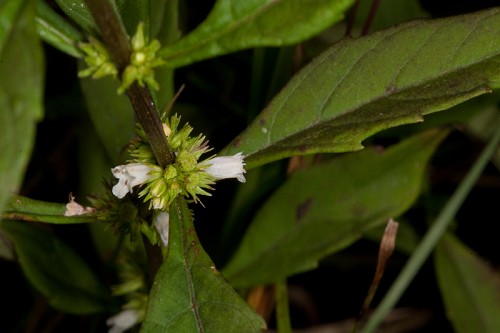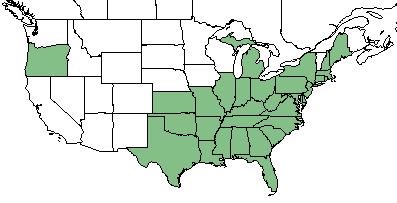Difference between revisions of "Lycopus rubellus"
| Line 30: | Line 30: | ||
==Ecology== | ==Ecology== | ||
===Habitat=== <!--Natural communities, human disturbed habitats, topography, hydrology, soils, light, fire regime requirements for removal of competition, etc.--> | ===Habitat=== <!--Natural communities, human disturbed habitats, topography, hydrology, soils, light, fire regime requirements for removal of competition, etc.--> | ||
| − | ''L. rubellus'' is found in marshes, swamp forests, and bottomlands.<ref name="Weakley 2015"/> On Arkansas floating mats, ''L. rubellus'' composed less than 1% of the vegetative cover.<ref name="Huffman & Lonard 1983">Huffman RT, Lonard RI (1983) Successional patterns on floating vegetation mats in a southwestern Arkansas bald cypress swamp. Castanea 48(2):73-78.</ref> | + | ''L. rubellus'' is found in marshes, swamp forests, and bottomlands.<ref name="Weakley 2015"/> On Arkansas floating mats, ''L. rubellus'' composed less than 1% of the vegetative cover.<ref name="Huffman & Lonard 1983">Huffman RT, Lonard RI (1983) Successional patterns on floating vegetation mats in a southwestern Arkansas bald cypress swamp. Castanea 48(2):73-78.</ref> In Indiana, ''L. rubellus'' grows on floating logs, stumps, and at bases of living trees.<ref name="Homoya & Hedge 1982">Homoya MA, Hedge CL (1982) The upland sinkhole swamps and ponds of Harrison County, Indiana. Proceedings of the Indiana Academy of Science 92:383-388.</ref> |
===Phenology=== <!--Timing off flowering, fruiting, seed dispersal, and environmental triggers. Cite PanFlora website if appropriate: http://www.gilnelson.com/PanFlora/ --> | ===Phenology=== <!--Timing off flowering, fruiting, seed dispersal, and environmental triggers. Cite PanFlora website if appropriate: http://www.gilnelson.com/PanFlora/ --> | ||
Revision as of 20:51, 1 February 2018
| Lycopus rubellus | |
|---|---|

| |
| Photo by the Southeastern Flora Database | |
| Scientific classification | |
| Kingdom: | Plantae |
| Division: | Magnoliophyta - Flowering plants |
| Class: | Magnoliopsida - Dicots |
| Order: | Lamiales |
| Family: | Lamiaceae |
| Genus: | Lycopus |
| Species: | L. rubellus |
| Binomial name | |
| Lycopus rubellus Moench | |

| |
| Natural range of Lycopus rubellus from USDA NRCS Plants Database. | |
Common Names: stalked bugleweed;[1] taperleaf water horehound[2]
Contents
Taxonomic Notes
Synonym: L. velutinus;[1][2] L. angustifolius[2]
Description
Lycopus rubellus is a dioecious perennial forb/herb.[2] It produces white flowers.[3]
Distribution
This species occurs from Maine, westward to Michigan, and southward to Florida and Texas.[1] Reports also exist for its occurrence in Oregon.[2]
Ecology
Habitat
L. rubellus is found in marshes, swamp forests, and bottomlands.[1] On Arkansas floating mats, L. rubellus composed less than 1% of the vegetative cover.[4] In Indiana, L. rubellus grows on floating logs, stumps, and at bases of living trees.[5]
Phenology
In the southeastern and mid-Atlantic United States, L. rubellus flowers from June through November.[1]
Seed bank and germination
After submerging seeds in a water filled jar for 130 days, speeds from L. rubellus still germinated and produced seedlings.[6]
Conservation and Management
Cultivation and restoration
Photo Gallery
References and notes
- ↑ 1.0 1.1 1.2 1.3 1.4 Weakley AS (2015) Flora of the Southern and Mid-Atlantic States. Chapel Hill, NC: University of North Carolina Herbarium.
- ↑ 2.0 2.1 2.2 2.3 2.4 USDA NRCS (2016) The PLANTS Database (http://plants.usda.gov, 01 February 2018). National Plant Data Team, Greensboro, NC 27401-4901 USA.
- ↑ Plant database: Lycopus rubellus. (01 February 2018) Lady Bird Johnson Wildflower Center. URL: https://www.wildflower.org/plants/result.php?id_plant=LYRU
- ↑ Huffman RT, Lonard RI (1983) Successional patterns on floating vegetation mats in a southwestern Arkansas bald cypress swamp. Castanea 48(2):73-78.
- ↑ Homoya MA, Hedge CL (1982) The upland sinkhole swamps and ponds of Harrison County, Indiana. Proceedings of the Indiana Academy of Science 92:383-388.
- ↑ Shull GH (1914) The longevity of submerged seeds. The Plant World 17(11):329-337.